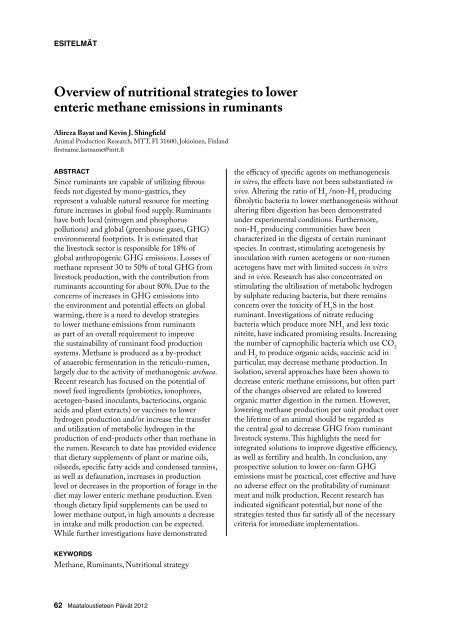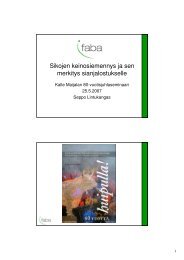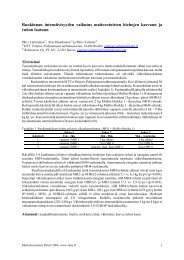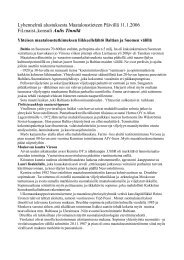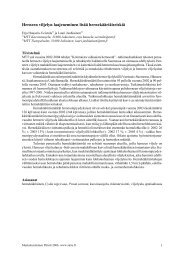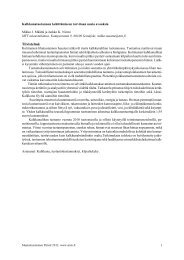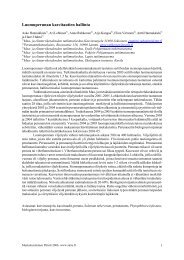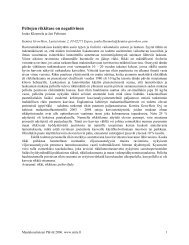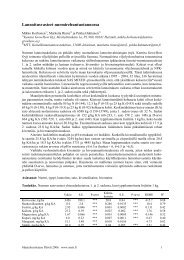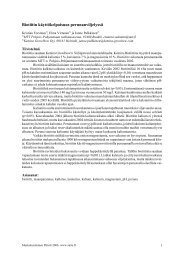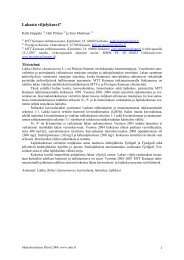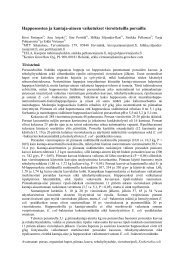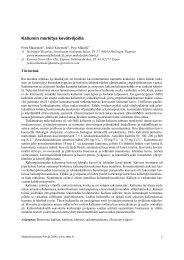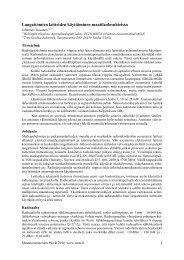Maataloustieteen Päivät 2012 - Suomen Maataloustieteellinen ...
Maataloustieteen Päivät 2012 - Suomen Maataloustieteellinen ...
Maataloustieteen Päivät 2012 - Suomen Maataloustieteellinen ...
You also want an ePaper? Increase the reach of your titles
YUMPU automatically turns print PDFs into web optimized ePapers that Google loves.
ESITELMÄT<br />
Kotieläintuotanto ja ilmastonmuutos<br />
Overview of nutritional strategies to lower<br />
enteric methane emissions in ruminants<br />
Alireza Bayat and Kevin J. Shingfield<br />
Animal Production Research, MTT, FI 31600, Jokioinen, Finland<br />
firstname.lastname@mtt.fi<br />
ABSTRACT<br />
Since ruminants are capable of utilizing fibrous<br />
feeds not digested by mono-gastrics, they<br />
represent a valuable natural resource for meeting<br />
future increases in global food supply. Ruminants<br />
have both local (nitrogen and phosphorus<br />
pollutions) and global (greenhouse gases, GHG)<br />
environmental footprints. It is estimated that<br />
the livestock sector is responsible for 18% of<br />
global anthropogenic GHG emissions. Losses of<br />
methane represent 30 to 50% of total GHG from<br />
livestock production, with the contribution from<br />
ruminants accounting for about 80%. Due to the<br />
concerns of increases in GHG emissions into<br />
the environment and potential effects on global<br />
warming, there is a need to develop strategies<br />
to lower methane emissions from ruminants<br />
as part of an overall requirement to improve<br />
the sustainability of ruminant food production<br />
systems. Methane is produced as a by-product<br />
of anaerobic fermentation in the reticulo-rumen,<br />
largely due to the activity of methanogenic archaea.<br />
Recent research has focused on the potential of<br />
novel feed ingredients (probiotics, ionophores,<br />
acetogen-based inoculants, bacteriocins, organic<br />
acids and plant extracts) or vaccines to lower<br />
hydrogen production and/or increase the transfer<br />
and utilization of metabolic hydrogen in the<br />
production of end-products other than methane in<br />
the rumen. Research to date has provided evidence<br />
that dietary supplements of plant or marine oils,<br />
oilseeds, specific fatty acids and condensed tannins,<br />
as well as defaunation, increases in production<br />
level or decreases in the proportion of forage in the<br />
diet may lower enteric methane production. Even<br />
though dietary lipid supplements can be used to<br />
lower methane output, in high amounts a decrease<br />
in intake and milk production can be expected.<br />
While further investigations have demonstrated<br />
the efficacy of specific agents on methanogenesis<br />
in vitro, the effects have not been substantiated in<br />
vivo. Altering the ratio of H 2<br />
/non-H 2<br />
producing<br />
fibrolytic bacteria to lower methanogenesis without<br />
altering fibre digestion has been demonstrated<br />
under experimental conditions. Furthermore,<br />
non-H 2<br />
producing communities have been<br />
characterized in the digesta of certain ruminant<br />
species. In contrast, stimulating acetogenesis by<br />
inoculation with rumen acetogens or non-rumen<br />
acetogens have met with limited success in vitro<br />
and in vivo. Research has also concentrated on<br />
stimulating the ultilisation of metabolic hydrogen<br />
by sulphate reducing bacteria, but there remains<br />
concern over the toxicity of H 2<br />
S in the host<br />
ruminant. Investigations of nitrate reducing<br />
bacteria which produce more NH 3<br />
and less toxic<br />
nitrite, have indicated promising results. Increasing<br />
the number of capnophilic bacteria which use CO 2<br />
and H 2<br />
to produce organic acids, succinic acid in<br />
particular, may decrease methane production. In<br />
isolation, several approaches have been shown to<br />
decrease enteric methane emissions, but often part<br />
of the changes observed are related to lowered<br />
organic matter digestion in the rumen. However,<br />
lowering methane production per unit product over<br />
the lifetime of an animal should be regarded as<br />
the central goal to decrease GHG from ruminant<br />
livestock systems. This highlights the need for<br />
integrated solutions to improve digestive efficiency,<br />
as well as fertility and health. In conclusion, any<br />
prospective solution to lower on-farm GHG<br />
emissions must be practical, cost effective and have<br />
no adverse effect on the profitability of ruminant<br />
meat and milk production. Recent research has<br />
indicated significant potential, but none of the<br />
strategies tested thus far satisfy all of the necessary<br />
criteria for immediate implementation.<br />
Genetic tools to mitigate<br />
the environmental impact of milk production systems:<br />
Experience with a multi-point individual cow methane<br />
measurement system<br />
E. Negussie, A.-E. Liinamo, E. A. Mäntysaari, M. Lidauer<br />
MTT Agrifood Research, Biotechnology & Food Research, Biometrical Genetics, 31600 Jokioinen, Finland<br />
ABSTRACT<br />
Methane is one of the most potent greenhouse<br />
gases with about 21 times the Global Warming<br />
Potential (GWP) of carbon dioxide. Methane<br />
emission by dairy cows is not only a significant<br />
concern for the environment but also represent<br />
a loss of energy for milk production. Dairy cows<br />
lose 6 to 12% of feed energy and 95% of which<br />
is released through mouth as eructated methane.<br />
The most important avenue for reducing methane<br />
emissions from dairy systems is by improving the<br />
productivity and efficiency of dairy cows, through<br />
better nutrition and genetics.<br />
Attempts to reduce the ecological foot print of<br />
milk production require a sound understanding<br />
of the genetic basis of methane emissions. This<br />
requires reliable techniques for the measurement<br />
of methane output from individual cows. Enteric<br />
methane from ruminants is an important but<br />
often difficult source to quantify on an individual<br />
basis. So far, many of the available measurement<br />
techniques are either slow, expensive, labor<br />
intensive and are unsuitable for large scale<br />
measurements which is a prerequisite for genetic<br />
studies. This study evaluated a non-invasive<br />
Photoacoustic Infrared Spectroscopy (PAS)<br />
technique for quantifying enteric methane output<br />
from the breath of individual dairy cows.<br />
The study was conducted at MTT experimental<br />
dairy herd in Minkiö. A total of about 40 firstlactation<br />
Finnish Ayrshire cows were included.<br />
Individual cow methane, carbon dioxide (CO 2<br />
),<br />
acetone, ammonia outputs were measured<br />
continuously over 3 weeks period using a multipoint<br />
PAS gas analyzer fitted to two feeding<br />
kiosks (sampling points). Whenever a cow visits<br />
a feeding kiosk, her breath was sampled and<br />
analyzed for the contents of the different gases.<br />
Measurements were made alternatively between<br />
the two sampling points and every other minute a<br />
gas was sampled and analyzed from each.<br />
Records from continuous three days<br />
measurements were analyzed. There were about<br />
6–14 repeated measurements on each of the<br />
different gasses per cow and a total of 1 690<br />
and 1 908 measurements from sampling point<br />
1 and 2, respectively. Ratio of CH 4<br />
:CO 2<br />
is<br />
concentration independent and can be used to<br />
quantify methane output in dairy cows. Thus for<br />
each cow, CH 4<br />
:CO 2<br />
ratios were calculated using<br />
measurements of these gasses. Basic statistical<br />
measures were calculated. Between and within<br />
individual variability were quantified and the<br />
repeatability of CH 4<br />
:CO 2<br />
were estimated using<br />
the General Linear Models (GLM) procedure.<br />
The overall mean(sd) of CH 4<br />
:CO 2<br />
from kiosk1<br />
and 2 were 0.071(0.049) and 0.073(0.042) and<br />
the repeatability of CH 4<br />
:CO 2<br />
were 0.56 and 0.57<br />
for kiosk1 and 2, respectively. Repeatability sets<br />
the upper limit to heritability. Compared to other<br />
studies, repeatabilities from this study are on the<br />
higher side and suggest the suitability of the PAS<br />
for individual cow CH 4<br />
measurements that is a<br />
requisite in genetic studies.<br />
KEYWORDS<br />
Dairy cows, Repeatability, Methane, CH 4<br />
:CO 2<br />
ratio, Photoacoustic Infrared Spectroscopy<br />
KEYWORDS<br />
Methane, Ruminants, Nutritional strategy<br />
62 <strong>Maataloustieteen</strong> Päivät <strong>2012</strong> <strong>Maataloustieteen</strong> Päivät <strong>2012</strong> 63


